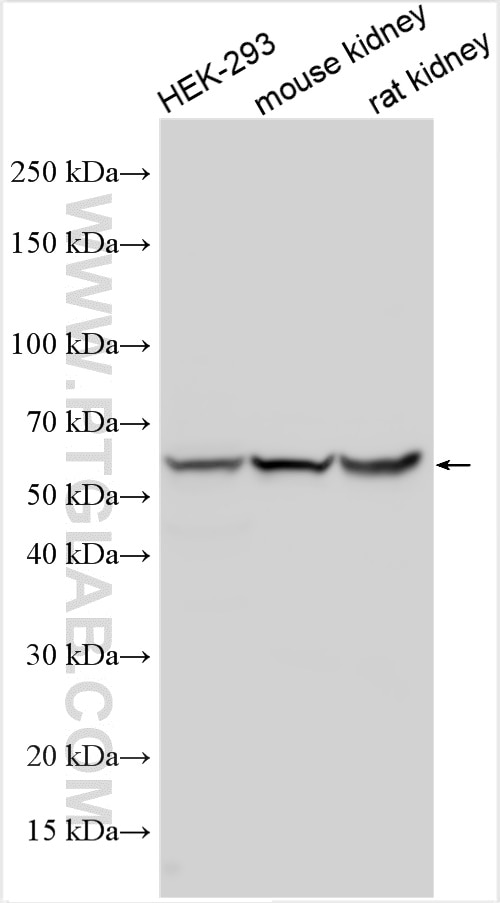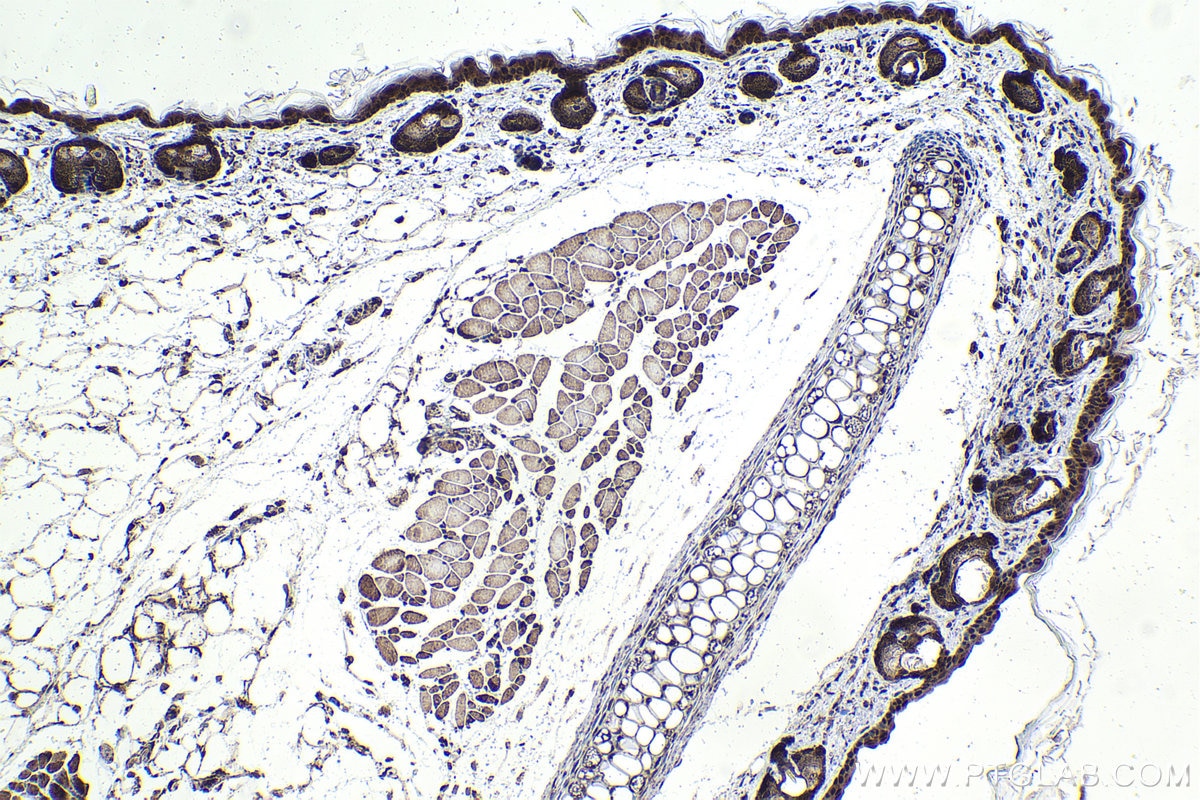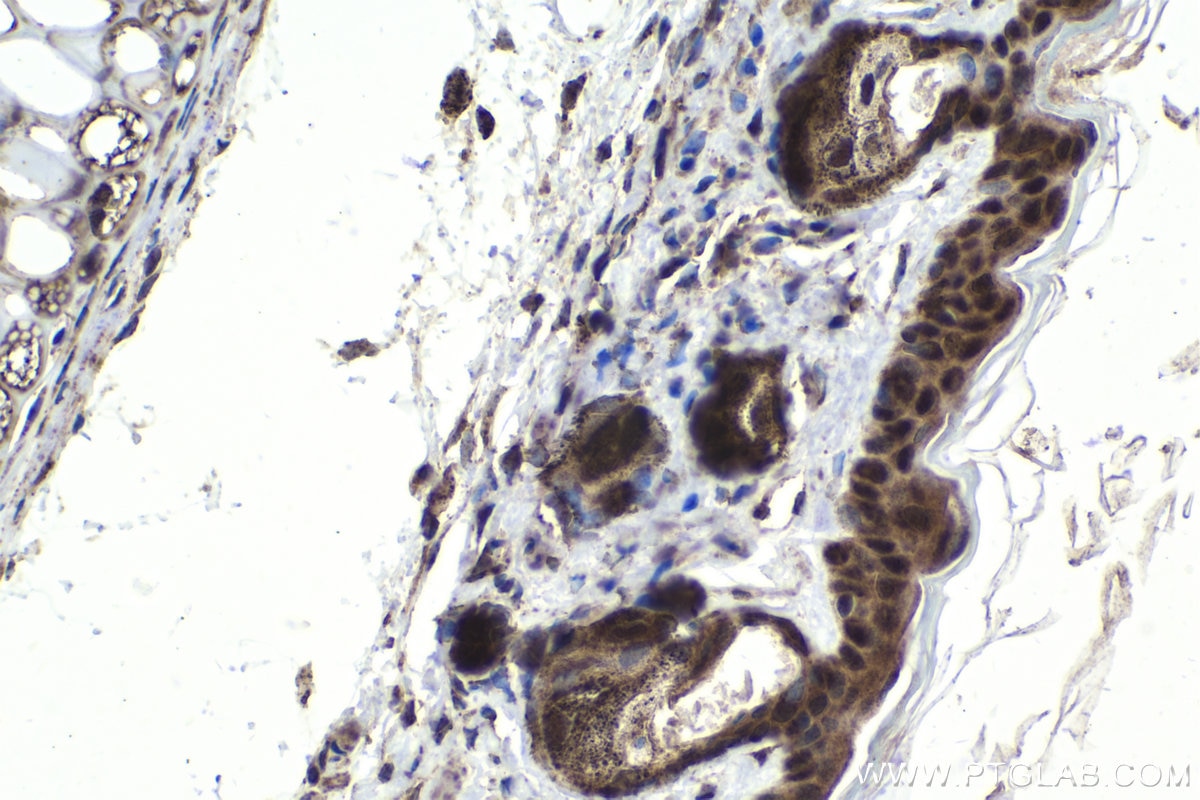IRF7 Polyklonaler Antikörper
IRF7 Polyklonal Antikörper für WB, IHC, ELISA
Wirt / Isotyp
Kaninchen / IgG
Getestete Reaktivität
human, Maus und mehr (2)
Anwendung
WB, IHC, IF, ELISA
Konjugation
Unkonjugiert
Kat-Nr. : 22392-1-AP
Synonyme
Geprüfte Anwendungen
| Erfolgreiche Detektion in WB | HEK-293-Zellen, Mausnierengewebe, Rattennierengewebe |
| Erfolgreiche Detektion in IHC | Maushautgewebe Hinweis: Antigendemaskierung mit TE-Puffer pH 9,0 empfohlen. (*) Wahlweise kann die Antigendemaskierung auch mit Citratpuffer pH 6,0 erfolgen. |
Empfohlene Verdünnung
| Anwendung | Verdünnung |
|---|---|
| Western Blot (WB) | WB : 1:2000-1:16000 |
| Immunhistochemie (IHC) | IHC : 1:250-1:1000 |
| It is recommended that this reagent should be titrated in each testing system to obtain optimal results. | |
| Sample-dependent, check data in validation data gallery | |
Veröffentlichte Anwendungen
| KD/KO | See 2 publications below |
| WB | See 21 publications below |
| IHC | See 4 publications below |
| IF | See 4 publications below |
Produktinformation
22392-1-AP bindet in WB, IHC, IF, ELISA IRF7 und zeigt Reaktivität mit human, Maus
| Getestete Reaktivität | human, Maus |
| In Publikationen genannte Reaktivität | human, Ente, Hausschwein, Maus |
| Wirt / Isotyp | Kaninchen / IgG |
| Klonalität | Polyklonal |
| Typ | Antikörper |
| Immunogen | IRF7 fusion protein Ag18059 |
| Vollständiger Name | IRF 7 |
| Berechnetes Molekulargewicht | 516 aa, 56 kDa |
| Beobachtetes Molekulargewicht | 55 kDa |
| GenBank-Zugangsnummer | BC136555 |
| Gene symbol | IRF7 |
| Gene ID (NCBI) | 3665 |
| Konjugation | Unkonjugiert |
| Form | Liquid |
| Reinigungsmethode | Antigen-Affinitätsreinigung |
| Lagerungspuffer | PBS with 0.02% sodium azide and 50% glycerol |
| Lagerungsbedingungen | Bei -20°C lagern. Nach dem Versand ein Jahr lang stabil Aliquotieren ist bei -20oC Lagerung nicht notwendig. 20ul Größen enthalten 0,1% BSA. |
Hintergrundinformationen
IRF-7 (IFN regulatory factor 7) is a member of the IFN regulatory transcription factor (IRF) family. IRF-7 has been shown to play a role in the transcriptional activation of virus-inducible cellular proteins, including IFN beta chain proteins. Inducible expression of IRF-7 is largely restricted to lymphoid tissue. Four transcript variants encoding distinct isoforms (A,B,C and D) have been identified for this (PMID:9786932).The active IRF7A exists as a dimer form ~80 kDa(PMID:11073981). The MW 67-70 kDa has been reported in some papers (PMID:9786932; 22951831).Various posttranslational modifications of IRF7 including phosphorylation, ubiquitination, sumoylation and acetylation are identified (PMID:22951831).This antibody is a rabbit polyclonal antibody raised against the C-terminal 349 amino acid residues of human IRF7 D. The molecular weight of Nonphosphorylated IRF7 cofractionated with the 44-kDa marker, approximating its predicted size. In contrast, phosphorylated IRF7, which migrate more slowly on SDS-PAGE. This phosphorylated IRF7 was consistent with a size of 80 to 90 kDa. (PMID: 11073981 )
Protokolle
| PRODUKTSPEZIFISCHE PROTOKOLLE | |
|---|---|
| WB protocol for IRF7 antibody 22392-1-AP | Protokoll herunterladen |
| IHC protocol for IRF7 antibody 22392-1-AP | Protokoll herunterladenl |
| STANDARD-PROTOKOLLE | |
|---|---|
| Klicken Sie hier, um unsere Standardprotokolle anzuzeigen |
Publikationen
| Species | Application | Title |
|---|---|---|
Cancer Lett NR4A1 depletion inhibits colorectal cancer progression by promoting necroptosis via the RIG-I-like receptor pathway | ||
Cell Chem Biol Identifying enhancers of innate immune signaling as broad-spectrum antivirals active against emerging viruses. | ||
J Immunol Inducible TAP1 Negatively Regulates the Antiviral Innate Immune Response by Targeting the TAK1 Complex. | ||
J Immunol Inducible ATP1B1 Upregulates Antiviral Innate Immune Responses by the Ubiquitination of TRAF3 and TRAF6. | ||
Phytomedicine Si-Ni-San ameliorates chronic colitis by modulating type I interferons-mediated inflammation. | ||
Cancer Med A regulatory mutant on TRIM26 conferring the risk of nasopharyngeal carcinoma by inducing low immune response. |




